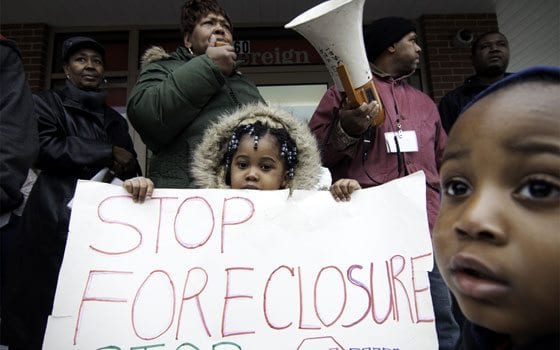

Author: Sandra LarsonAn image from “We Shall Not Be Moved,” showing children at an anti-foreclosure protest.
Dorrett Martin refinanced her Blue Hill Avenue home of 25 years while caring for her ill mother. She lost her job, could no longer make the higher mortgage payments and went into foreclosure. Her foreclosure also threatened her longtime tenant Sandra Douglas, with whom Martin developed a deep friendship over 24 years in the three-family house.
Ken Tilton lost his Roxbury condominium after his partner died of cancer, racking up impossible medical bills during 15 months of illness.
Reggie Fuller and Louanna Hall are fighting eviction from the Dorchester apartment they call home, after the landlord went into foreclosure and left the building vulnerable to criminal activity, disrepair and even a fire.
These are a few of the human stories behind the nearly 4,000 foreclosures Boston has seen in the past five years, in a crisis concentrated disproportionately in high-minority neighborhoods such as Dorchester and Roxbury.
But these individuals are not going down without a fight. With the help of City Life/Vida Urbana (CLVU), a Boston housing advocacy group, they, along with hundreds of others, have dug their heels in against eviction while working to reclaim their homes.
Their faces and stories are part of “We Shall Not Be Moved,” an exhibit now on display at the Washington Street Art Center in Somerville after an initial week-long run at the Great Hall in Dorchester last month.
Somerville photographer Kelly Creedon set out in 2008 to explore, with her camera and a tape recorder, the suffering and strength within the foreclosure crisis. She had heard about CLVU from friends who had attended “eviction blockades,” where CLVU organizers and volunteers band together to stop tenants and former homeowners from being forcibly moved out.
“I felt personally moved by what I was hearing,” said Creedon. She decided photography would be a new way to bring the story home to people desensitized by an onslaught of facts and figures.
For more than two years, she followed CLVU’s burgeoning anti-foreclosure movement, attending Tuesday evening meetings week after week, interviewing people in their homes and documenting rallies and protests. Along the way, she received grants from Mass Humanities and the Puffin Foundation to keep the project alive. She estimates she took 10,000 photographs, and selected 27 of them for this exhibit.
One group of images features Marshall Cooper Jr., 75, who bought his Dorchester home 15 years ago after taking early retirement to take care of his ill parents.
Cooper was at the exhibit’s opening reception. Standing near his portrait, he spoke about his path to foreclosure, echoing some of what can be heard in the audio slideshow Creedon created for the exhibit.
“My mom and dad both got sick,” Cooper explained. “They were separated, and I was going to two places to comfort them. I took early retirement and bought this house to bring them together.”
Not able to qualify for a good loan, as he was no longer employed and had bad credit, he said, he was referred to a lender willing to give him a mortgage at twice the interest rate, as long as he put his entire savings of $34,500 down.
“They knew I didn’t have a job. They knew down the line they were going to get that house back,” he said bitterly. When the monthly payment rose from $1,210 to $1,740 and then to $2,290, it was a lost cause. Eventually, when he was caring for his parents “23 hours a day,” the foreclosure notice came.
Cooper relies heavily on his cane to walk, but that hasn’t stopped him from being an active participant in CLVU’s foreclosure protest movement.
“Everywhere City Life goes, I try to go there,” he said, ticking off events such as eviction blockades, auction interventions, rallies and protests.
“If you’re going along smoothly in life, you don’t know what’s happening to others,” he continued. “Sometimes you have to sacrifice, because when it’s your turn, you want someone to be there with you. Now I’m helping someone else — even if I don’t get my house back.”
But he is optimistic about regaining his house. Boston Community Capital (BCC), a nonprofit lender headquartered in Roxbury’s Dudley Square, is negotiating with the bank to purchase Cooper’s home and then resell it to Cooper at a price in line with the current market — a price he can afford. So far BCC’s intervention has enabled dozens of CLVU members to buy their homes back at payments they can afford.
At the “We Shall Not Be Moved” reception, Abigail Gnall, 33, browsed the exhibit. Seeing the photographs was an eye-opener for her, she said, and would likely be for many others.
“Foreclosure feels like something that happens to someone else, somewhere else — not just down the block,” she said. “For [Creedon] to be able to put a face on that, that’s when it becomes real. You can’t just shake your head and cluck your tongue anymore.”
Gnall pointed at some of the portraits that had caught her eye so far. “You can see they’re being devastated by it,” she said. “It’s crazy.”
“We Shall Not Be Moved” is on display through March 30 at the Washington Street Art Center, 321 Washington St., Somerville. For more information and to see images and video footage of the homeowners and tenants documented in the exhibit, see http://weshallnotbemoved.net.






